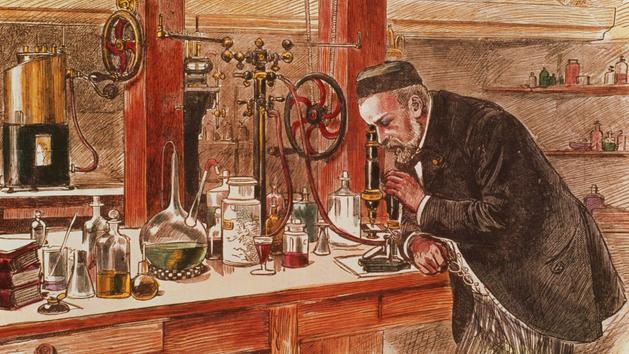Louis Pasteur, a flamboyant journey. Famous for having invented the treatment against rabies, it was on July 6, 1885 that he tested his treatment for the first time on a young boy. It is a success. Le Figaro follows with interest and passion the journey of this brilliant scientist by informing readers of the progress of this work. "Mr. Pasteur in pursuing this path of the study of microbes has opened a vast horizon and such a great place among the benefactors of humanity" writes the newspaper during its reception at the French Academy. At the inauguration of the famous Institut Pasteur Le Figarodo not miss this beautiful ceremony. In 1894 a subscription in the newspaper mobilized the reader to fight against diphtheria. The whole life of the illustrious scientist is punctuated by his research and his discoveries, among which we remember pasteurization techniques and vaccination against rabies.
See this post on Instagram
On July 6, 1885, scientist Louis Pasteur tested his treatment on the young Joseph Meister, bitten by a rabid dog. "The death of this child seems inevitable, I decided, not without cruel and lively worries, it must be thought, to try on Joseph Meister the method that had constantly succeeded on dogs". This first vaccination is a success. The boy will not develop rabies. This treatment is thus the first case of rabies vaccination of a human subject. Credit: Rue des archives #louispasteur #vaccin #vaccination #institutpasteur
A publication shared by Figaro Archives (@figaroarchives) on Jul 5, 2020 at 10:36 PDT
See also: July 6, 1885: Pastor vaccines Joseph Meister against rabies
Gustav Mahler, he perfectly masters the rhythm, the melody. Born July 7, 1860, Mahler is a great conductor. He has directed the largest international ensembles (Leipzig, Hamburg, Prague, Budapest, Vienna, New York). Under his direction, the Vienna Opera excels. Also a composer, the company of women regularly inspires him with musical works. In 1901, he fell head over heels in love with Alma Schindler, a painter and musician. They get married. Very authoritarian, the musician forbids him to compose and forces him to give up all personal ambition. "You now have only one profession: to make me happy." Yet promised a bright professional future, she submits and lives to the rhythm of her husband's creations. With his ten symphonies, Mahler was prolific and contributed to the development of the romantic symphony, born under the pen of Beethoven.
See this post on Instagram
A figure of German musical art. Born on July 7, 1860, in Bohemia, Gustav Mahler was quickly noticed for his musical gifts: he studied the piano and orchestration. Became conductor of the Vienna Opera, an internationally renowned lyric scene, he then took the reins of the New York Philharmonic Orchestra in 1908. The musician left us nine symphonies. Symphony No. 2, conceived by Mahler as the victory of man over death, remains his most ambitious work. Credit: Rue des Archives #gustavmahler #composer #orchestra #symphonie #classicalmusic #classicalmusic
A publication shared by Figaro Archives (@figaroarchives) on Jul 6, 2020 at 11:41 PDT
Read also: Mahler, only happiness
Music notes are also his domain. The learned and industrialist Émile Guimet was fond of music. His name is commonly associated with his museum, whose reopening was mentioned on July 8 , but music is his passion from an early age. A well-informed music lover, he never stops composing - songs, pieces for piano, an oratorio or even a ballet - and teaches singing by founding choirs. His major work is the opera in five acts Tai-Tsoung performed in Marseille in 1894, a lively portrait of medieval China. Fascinating character with multiple talents, Émile Guimet is also recognized for his entrepreneurial journey (he creates mutuals, retirement funds for his workers), his audacity in traveling the roads of the world, and the objects he collects during of these trips. Its museum beyond collections is also "a factory of ideas": from the inauguration of the museum in 1889, the ambition of the establishment is to constitute an encyclopedia of religions, and to allow their knowledge and understanding.
See this post on Instagram
The Guimet museum in Paris reopens after months of confinement. Do you know Émile Guimet, brilliant founder of the museum that bears his name? A multifaceted character. Passionate about music, he quickly took over the reins of the paternal industry near Lyon (his father invented artificial ultramarine blue). Frequent traveler, curious man, he left for a world tour with his painter friend Félix Régamey. From these journeys, he piled up a lot of collections and immersed himself in the history of religions. Émile Guimet opened a museum in Lyon and then moved it to Paris. The official inauguration took place on November 20, 1889. Credit: Rue des Archives (photos: 1. Émile Guimet, 2. during his trip to Japan with interpreters, 3. painting by the painter Félix Régamey #museeguimet #emileguimet #paris # religion #buddhism #orientalism
A publication shared by Figaro Archives (@figaroarchives) on Jul 8, 2020 at 12:34 PDT
Read also: Guimet Museum: the story of the inauguration in Le Figaro of 1889
We also mentioned the birth of Jean Cocteau on July 5, 1889. A complete artist, apart from musical talent. But we owe Cocteau a rich collaboration with musicians: more than 600 texts by the poet have been set to music.
If you like history join us on @figaroarchives

